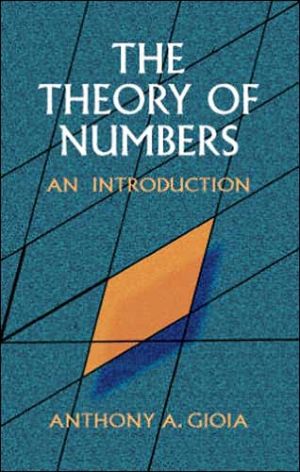

 |

|

The average rating for The theory of numbers based on 2 reviews is 3 stars.
Review # 1 was written on 2014-10-16 00:00:00 Matthew Duncan Matthew DuncanIf you're into stuff like this, you can read the full review. ζ (s) = 0: “Dr. Riemann's Zeros” by Karl Sabbagh After having read Sabbagh’s book a General Solution to the Riemann Hypothesis popped up in my tiny little brain. Here it is. ζ(0) = negative one half = non trivial zero. Proof: 1. Superimpose two unit circles. 2. Designate the vertical diameters as 2i and the horizontal diameters as 2x. 3. Starting at zero degrees and rotating counterclockwise, the points of axes along the circumference then assume the values (1, 0); (0, i); (-1, 0) and (0,-i). 4. Pin the common point of the two unit circles at (1; 0) such that this point is restricted from moving. 5. Reduce the diameter of one of the unit circles by half. This creates an inner circle of diameter i vertically and diameter x horizontally, which is pegged/pinned to the larger unit circle at point (1; 0): 6. This pegged inner circle is identical in every respect to the larger parent unit circle except it has been scaled to half the size of the larger unit circle. 7. The origin of the parent unit circle assumes various equivalent values Cartesian: zero, plus or minus 1. Continued elsewhere. |
Review # 2 was written on 2012-01-28 00:00:00 Jan Michael Magbag Jan Michael MagbagThe Riemann Hypothesis is easily one of the most important unsolved problems in mathematics. Unfortunately, unlike Fermat's Last Theorem or even the Poincaré conjecture, the Riemann Hypothesis doesn't lend itself well to being put in layman's terms. Even still, Sabbagh gives quite the valiant effort in his book, and in the process takes us into the strange world of cutting-edge mathematics. Sabbagh's trip through the Riemann Hypothesis is a slow, methodical one: he starts out with some required fundamentals: prime numbers, imaginary numbers, complex numbers, and works his way up to more esoteric topics like infinite series, zeta functions, and finally what Riemann's Hypothesis says about the zeros of these functions. Along the way, Sabbagh introduces various mathematicians whom, although you've probably never heard them, are larger-than-life in their own right, and what life is like for these people who concentrate intensely on very abstract concepts. As I've mentioned in other reviews, I love books that talk about the 'romantic' side of mathematics, and Sabbagh does a wonderful job of that in his book. Many of the mathematicians he interviewed I had never heard of before, but their stories were so enthralling that I never once felt a twinge of boredom. My only real criticisms of the book lie in it's flow. I know that trying to explain the Riemann Hypothesis in non-mathematical language is a very daunting task, but the explanations and analogies scattered throughout the book didn't seem to flow well enough to paint an overall picture for me. Also, in some areas, Sabbagh seemed to diverge quite a bit from the main topic of the book. Although the segues themselves are interesting topics, again I felt it disrupted the overall flow. If you're like me, and you followed the stories behind Fermat's Last Theorem and the Poincare conjecture, I definitely recommend picking up Sabbagh's book and discovering the weird and fascinating world of Riemann's Hypothesis. |
CAN'T FIND WHAT YOU'RE LOOKING FOR? CLICK HERE!!!